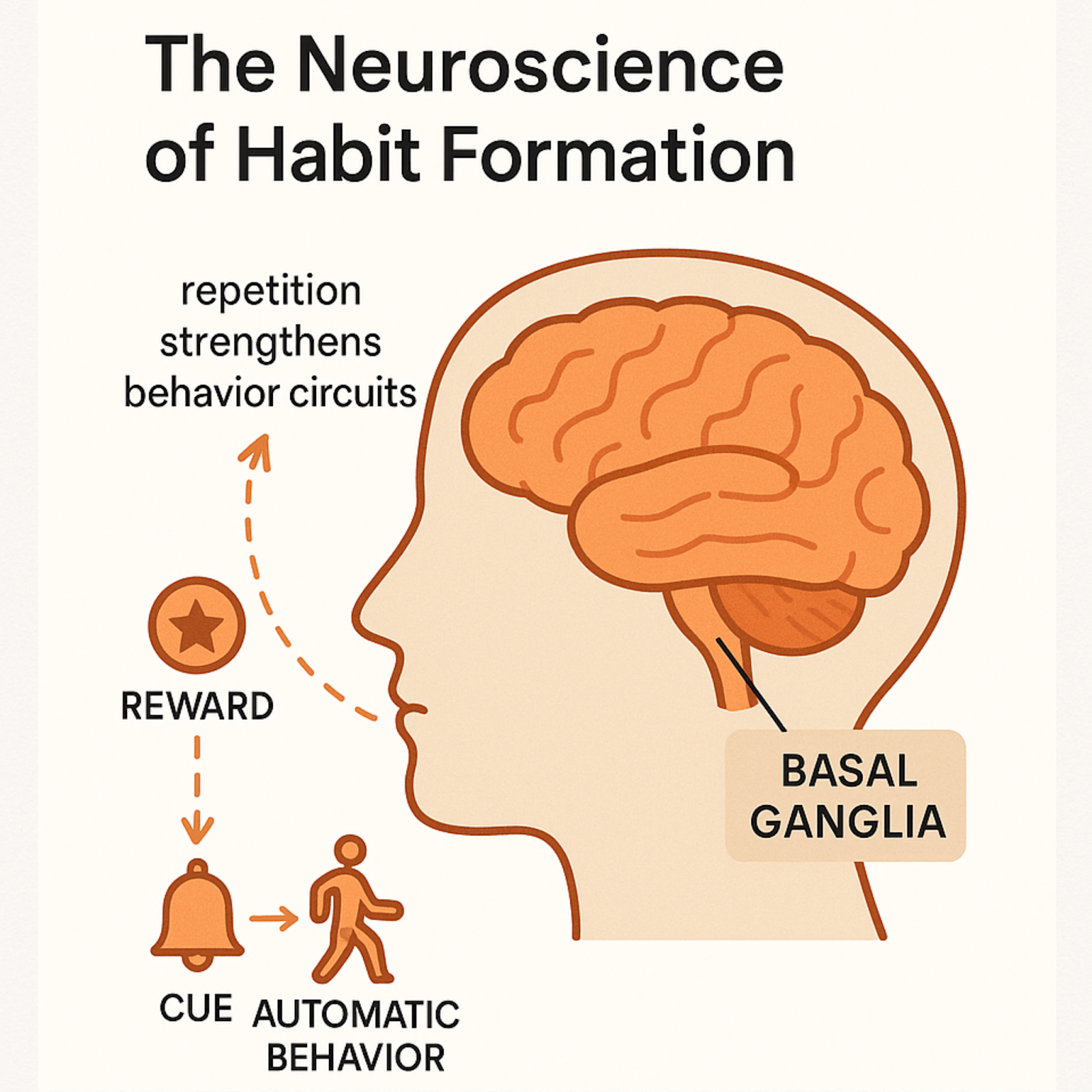The Science of Habit Formation: How to Build Healthy Habits That Stick
Building a new habit, whether it is exercising regularly, choosing nutritious meals, or sleeping better, can seem straightforward at first. Yet, many of us find that motivation wanes, or life’s demands derail our best intentions. Why is it so tough to form habits that truly stick? The answer lies in understanding the psychology and neuroscience of behaviour change. This article delves into scientific insights on habit formation (including the role of context and environment) and explores how strategies like nudging and social marketing can create supportive spaces for lasting healthy routines.
We will also connect these principles to a real-world intervention reported in the article “Using nudging and social marketing techniques to create healthy worksite cafeterias in the Netherlands: intervention development and study design” (Velema et al., 2017). Together, these insights offer you the knowledge to turn passing intentions into ingrained actions that genuinely improve your daily life.
What Is Habit Formation and Why Does It Matter?
According to psychological and neuroscience perspectives, a habit is an automated response to a cue, typically rewarded by some positive outcome (e.g., relief, pleasure, convenience). Over time, this cycle, cue → routine → reward , becomes ingrained in the brain’s circuitry, making the behaviour effortless to repeat.
When we talk about healthy habits , like regularly opting for fruit over crisps ,these repeated decisions can lead to a cascade of well-being benefits, from stabilising energy levels to preventing chronic illnesses. Conversely, unhealthy habits can accumulate and undermine physical and mental health. That’s why the science of habit formation is such a key area of interest for public health researchers and organisations.
Habit loops can run on autopilot, which means they can be harnessed for positive change.
Creating a new habit requires consistency , repetition in the same context.
Environmental cues often trigger these loops. For instance, seeing a snack machine can prompt impulse purchases.
The Neuroscience Behind Habit Loops
Researchers note that repeated actions eventually “rewire” parts of the brain responsible for motivation and self-control, including structures like the basal ganglia. Each time you follow the cue-routine-reward loop, the neural pathways that support that routine strengthen, making the behaviour feel increasingly automatic. James Clear, a writer on habit formation, describes how, without a satisfying reward, the habit loop never fully closes and is less likely to become ingrained.
Key Points:
Reward matters. Even small doses of positive emotion (like a sense of accomplishment) reinforce behaviour.
Environmental consistency fosters habit strength. Doing the same routine in the same context daily helps embed it.
Stress or disruption can erode newly forming habits if you do not anchor them securely.
The Role of Environment Insights from Nudging
Nudging refers to subtly altering options or cues in the environment to encourage certain behaviours, without removing personal freedom. This concept is grounded in behavioural economics and has proven effective at shaping food choices and other health-related behaviours. Nudges often emphasise:
Visibility and accessibility of healthier or more desirable options.
Small prompts (like signs or visual cues) that remind people of a beneficial choice.
Social norms that highlight how most peers choose the healthier option.
In their paper on creating healthy worksite cafeterias, Velema et al. (2017) discuss how strategic product placement and subtle changes in portion sizes or signage can steer employees toward better meal decisions,often without them realising it. This approach is especially powerful because it does not rely on willpower alone. Instead, it re-engineers the environment to make healthy choices easier, if not the default.
Putting a fruit bowl on the kitchen table instead of hiding it in the crisper
Displaying water bottles at eye level in a fridge, while sugary drinks go on a lower shelf.
Offering healthy default side dishes and letting people explicitly opt for the unhealthy alternative if they want it.
Social Marketing: Making Healthy Options Appealing
Beyond nudging, social marketing uses commercial marketing principles, think product, price, place, and promotion, to shape behaviours in service of the public good. According to Velema et al. (2017), these two strategies, nudging and social marketing, can be combined to design cafeterias that look attractive, highlight healthy meals, and reframe what “normal” eating patterns should look like at work.
Product: Introduce healthier meal options (like wholegrain sandwiches or salads).
Price: Make these dishes cost-competitive or cheaper than less healthy alternatives.
Place: Position healthy foods prominently at entrances or near checkouts, so they are more likely to be noticed.
Promotion: Craft messaging or visual design that emphasises the rewards of healthier eating (e.g., “Feel energised by lunch”).
It is not about deception or hiding treats, it is about rebalancing the context so that making a better choice doesn’t feel like swimming upstream. Interestingly, these strategies mirror the habit loop approach: a compelling cue (such as an eye-catching poster) combined with a satisfying outcome can reinforce repeated healthy choices.
Habit-Building Strategies: Practical Steps to Success
While large-scale interventions transform contexts at a group or workplace level, individuals can also adopt proven strategies to cultivate healthy habits in their personal lives. Below are some science-backed tactics from experts in habit formation, gleaned from multiple sources including theijbm.com, medium.com/habithook, and mindhealth.com.au.
Start Small and Specific
Many attempts at habit building fail because the change is too big and vague. For instance, “I want to get fit” lacks the clarity your brain needs. Instead, pick a small, easily doable action, like “Walk for 10 minutes after lunch, Monday to Friday.”Identify the Cue
If you want to eat more fruit, place fruit in a visible container on the counter as a cue. If you aim to drink more water, keep a water bottle within arm’s reach as you work. The more visible or accessible the cue, the easier it is to initiate the habit routine.Stack It with Existing Behaviours (Habit Stacking)
Tie your new habit to something you already do automatically. For example, “After I brush my teeth at night, I’ll do 30 seconds of stretching.” This approach uses your existing routine as a reliable prompt.Incorporate Rewards
Consider small, healthy rewards to reinforce your new habit. That might be listening to your favourite podcast only when you go for a walk. The reward is immediate and tied to the behaviour, accelerating habit acquisition.Track Progress and Adapt
Regularly monitor whether you are hitting your habit targets. If you find yourself slipping, revise your approach. Maybe the timing is off, or the reward isn’t compelling enough. Ongoing self-reflection and adaptation keep habits from fading when life changes.
Insights from the Dutch Worksite Cafeteria Study
In the intervention described by Velema et al. (2017), Dutch researchers aimed to redesign the food environment in 30 workplace cafeterias using both nudging (placement, signage, portion sizes) and social marketing (promotions, pricing). While the primary goal was a collective shift in employee choices, the underlying principle remains one of habit change:
Repeatedly encountering attractive, affordable, healthier foods fosters a potential daily “cue” that leads to consistent “routine” (choosing the healthy option).
Feeling physically better after a lighter lunch or saving money due to reduced pricing can act as the “reward.” Over time, employees might form a stable habit of seeking out these items.
The team measured changes in actual sales data to see if employees were making healthier purchases. This method bypasses self-report bias, often a problem in nutritional studies, and focuses on objective outcomes. The study design underscores how essential environmental design is for habit building on a larger scale.
Connection to Personal Habit Formation:
At work, you might have minimal control over the cafeteria layout, but you can advocate for healthier defaults or share feedback with management.
By aligning your personal dietary goals with the environment your company provides, you reduce friction between your aspirations and day-to-day surroundings.
Overcoming Common Obstacles in Building Healthy Habits
Lack of Immediate Results
Many healthy habits, such as choosing nutrient-dense meals or doing short exercise sessions, have delayed benefits. This can reduce motivation. To counter this, create short-term “emotional rewards”, like celebrating small wins or tracking daily progress visibly.
All-or-Nothing Thinking
Perfectionism can sabotage progress. If you slip up and have a less nutritious lunch, do not abandon the entire effort. Instead, focus on the next meal as an opportunity to realign. The best habit-builders are adaptable rather than rigid.Environmental Pitfalls
Places that encourage junk food, vending machines, or mindless snacking can undermine consistent habits. Proactively design your personal micro-environments (e.g., car, desk, fridge) to reduce negative cues. Meanwhile, if your employer offers an unhealthy cafeteria, consider suggestions or feedback to incorporate constructive nudges.Social Pressures
Friends or colleagues might inadvertently pressure you to eat unhealthily or skip a workout. Setting boundaries and communicating your goals can mitigate this. Alternatively, find a buddy or supportive group that shares your healthy habit ambitions.
Embracing Nudges and Social Marketing in Your Daily Life
Even if you are not a public health official or cafeteria manager, you can apply nudging and social marketing principles on a personal scale:
Curate Your Food Landscape: Rearrange your kitchen so that produce is eye-level, treats require extra effort.
Rebrand Your Meal Space: Consider creative signage or motivational quotes near the dining area.
Auction the “Value” of Health: Reward yourself or your family members for consistently choosing wholesome meals.
Normalise the Right Behaviours: Publicly celebrate your small wins with friends or via social media, establishing that healthy habits are the “norm” in your circles.
In many ways, social marketing and nudging are about shifting perspective on what’s appealing. By tapping into these strategies, your daily environment moves from being a barrier to being a partner in sustaining new behaviours.
Pulling It All Together A Roadmap to Lasting Habit Formation
Combining micro-level habit strategies with macro-level environment design can set you up for success:
Identify the habit you want (be specific).
Pinpoint frequent triggers or cues in your routine or environment.
Engineer an immediate reward, like a quick celebration, a positive self-statement, or something tangible (a favourite podcast).
Make the new behaviour easy: remove friction or potential barriers.
Reframe your environment to nudge you forward, from rearranging your shelves at home to advocating for changes at your workplace.
Seek social accountability, whether from friends, online communities, or family.
Evaluate and adapt regularly, life changes, and your plan should, too.
This layered approach ensures your new habit is not just a hopeful idea but a robust routine underpinned by carefully designed cues, reinforcements, and social support.
Conclusion
The science of habit formation underscores that our choices are rarely driven by brute willpower alone. They emerge at the intersection of personal motivation, external cues, and deeper brain mechanisms shaping behaviour over time. By harnessing the power of habit loops, and strategically designing our environments through nudging or social marketing, we can turn healthy actions into self-sustaining habits.
Velema et al. (2017) provide a real-world example of how these principles scale up from an individual to an entire workplace setting. By tweaking cafeteria designs, pricing, and promotions, workplaces can help employees develop long-lasting dietary habits without imposing uncomfortable restrictions. On an individual level, adopting similar mindsets, cue-based routines, short-term rewards, environment rearrangements, will help you build healthy habits that endure.
Rather than focusing on “trying harder,” focus on working smarter, using scientifically backed techniques that align with the way our brains naturally learn and repeat behaviours. Whether you are aiming to eat more fruit, work out more consistently, or reduce portion sizes, setting up the right triggers, routines, and rewards can transform your daily actions from fleeting intentions into lifestyle changes that last.
Ready to put these ideas into practice? Start reshaping your routine by identifying one micro-habit you can do daily, no matter how small. Need more inspiration or community support? Share your journey with family or colleagues and become the architect of your own healthy environment!



